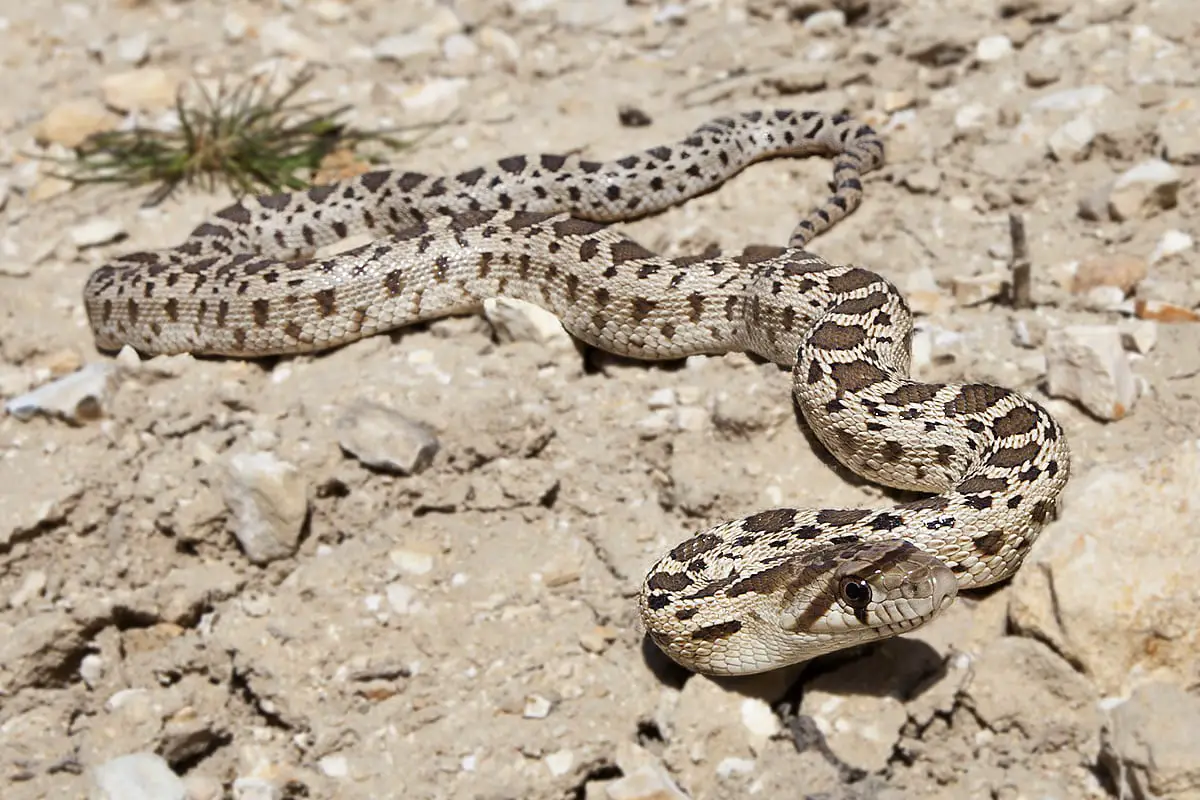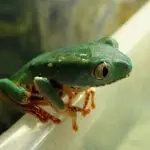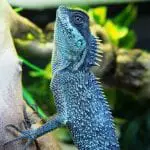Scientific Facts
| Scientific Classification | Reptilia |
| Scientific Name | Pituophis catenifer |
| Size | Up to 7 ft. long |
| Weight | 2 – 4 lbs. |
| Special Physical Traits | Light-colored with dark blotches and spots |
| Life Span | 12 – 15 yrs. |
| Habitat | Deserts, scrublands, forests, urban areas, grasslands, coastal dunes |
| Diet | Carnivore |
| Social Lifestyle | Solitary |
| Favorite Food Source | Rodents (typically) |
| Predators | Humans, birds of prey, large mammals, other snakes |
Physical Description
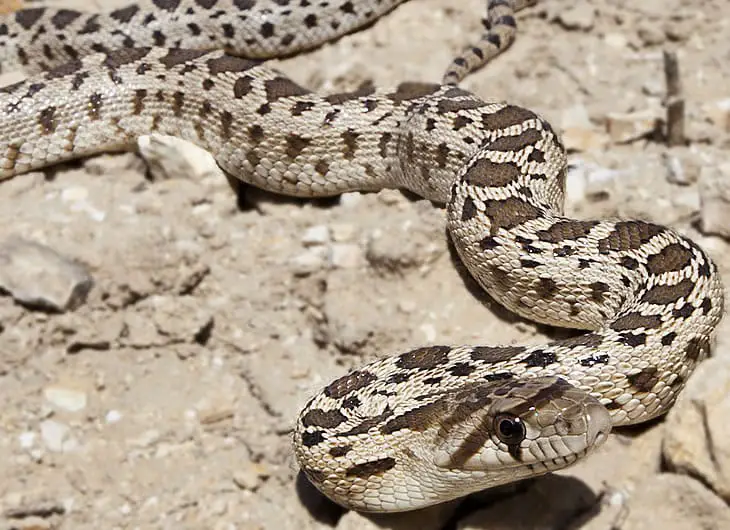
Gopher Snake is described as a large and powerful snake. Both male and females are asexually alike with no differences in weight, size and physical appearance. They have a ranging color of cream to light brown with dark blotches seen on their backs and along their sides. There are a total of 41 to 99 spots all over their body and 14 to 33 spots seen on their tails while the sides of their body have 2 or 3 rows of black and brown spots.
Compared to other types of snakes, they have relatively large eyes with large heads that has two dark lines that pass through on the sides of their eyes. Their whole body is covered with keeled scales and the tip of their snout has protruding rostral scale. There is a confusion between gopher snakes and rattlesnakes because they almost have the same appearance and exhibits almost the same behavior when threatened such as the way of hissing. Unlike rattlesnakes, gopher snakes are non-venomous that is why it is not a good point to mistake their identity.
Where it is seen?
Gopher Snakes are usually seen in the West Coast of the United States up to the Southern Coast of California. They rarely saw about 2000 above sea level. They are also distributed in Southern British Columbia, Alberta, and Mexico.
Gopher Snake Subspecies
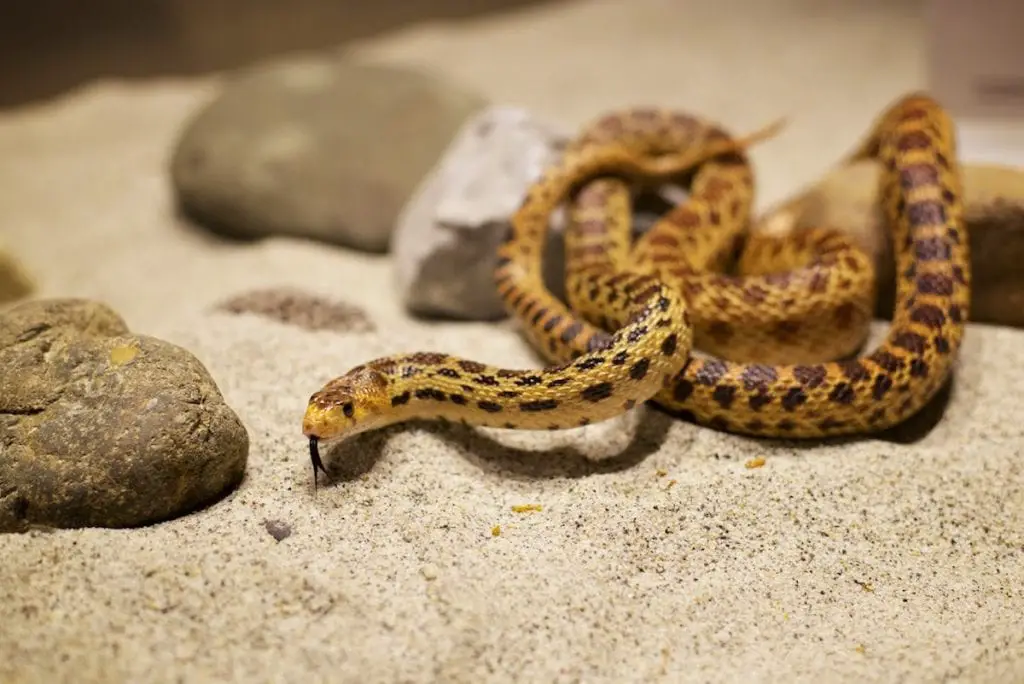
1) The Sonoran Gopher Snake
As its name implies, it is from the Sonoran Desert. The Sonoran Desert covers large parts of North-western Mexico, California, and Arizona. This is the hottest desert in Mexico that is why these snakes prefer hot and dry climates. It is considered as one of the biggest snakes that can grow up to seven and a half feet in length but this size would depend on how well it is being fed, especially in captivity.
2) The Pacific Gopher Snake
This subspecies of gopher snake is smaller compared to its cousins that only grows about a maximum of five feet. They are very good at camouflaging because of their yellow-brown color that fits the environment. They are an excellent type of gopher snake to pet because in captivity they can live up to 30 years.
3) The Bull Snake
This is the type of gopher snakes that looks much like rattlesnakes with their color and pattern, the texture of scales and movements. They are not venomous but they are constrictors. They are not the best type of gopher snake to take in captivity because they are bad-tempered and notoriously defensive.
4) The Great Basin Gopher Snake
This type of gopher snakes loves to thrive in woodlands, grasslands and in an environment where they can swim because they are a good swimmer. If taken in captivity, it is much easier to mimic their natural environment. As the name implies, they are commonly seen in the largest area of contiguous endorheic watersheds in North America which is the Great Basin.
Habitat
They are found in a wide variety of habitats such as coastal dunes, coniferous forests, grasslands, and open brush areas. Within these habitats, their favorite hideout includes dense vegetation, burrows, trees and rocky outcroppings that range from below sea level to over 9000 feet (2700 m). They are also attracted to urban areas, like parks, gardens, and suburban neighborhoods that have the presence of potential prey.
Size
The adult gopher snake has a size ranges from 3–7 feet (91–213 cm) The hatchlings are relatively long, and they have been recorded at lengths upward of 20 inches (51 cm).
Behavior
These snakes are a slow-moving reptile and they can be intimidating because of their muscular built and long size but they are non-venomous. They kill their prey by constriction and suffocation. When they are agitated they hiss loudly, flatten its head and body, and shake its tail. They are mainly diurnal but during the summer period, they adjust to the intense heat by changing their activity patterns at night making them nocturnal.
They can’t live a day without basking. If they happen to be on the road, they would usually stretch out completely risking to be run off by vehicles. Their behavior is just like rattlesnakes but they are more captive-friendly because they do not possess harmful venom that may be fatal to humans.
Eating Habits
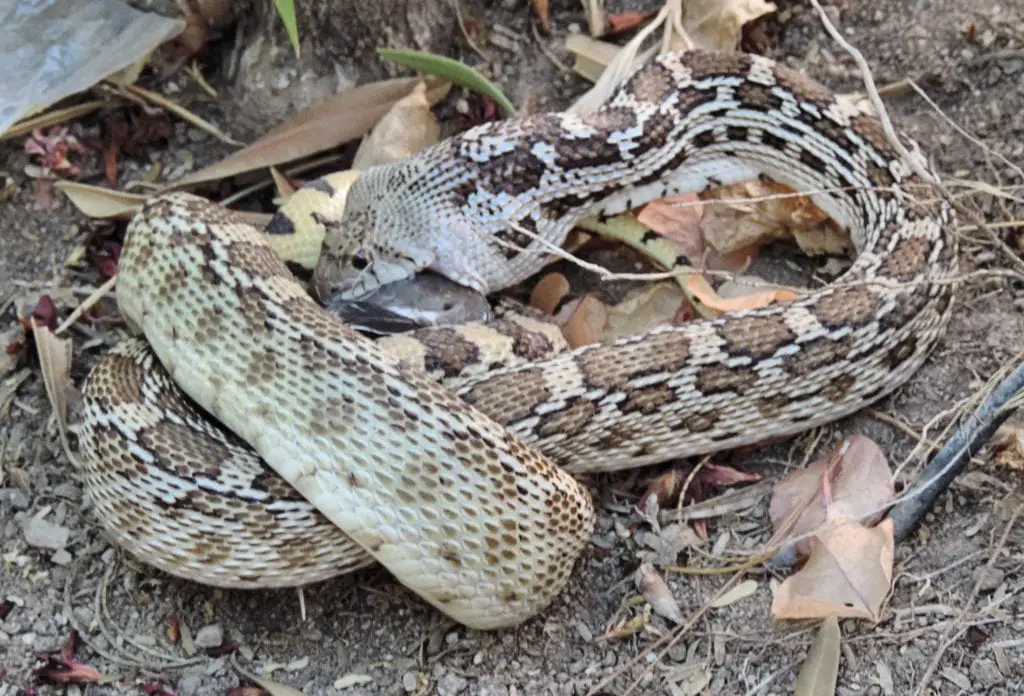
The diet of Gopher snakes consists of small mammals, lizards, insects, bats, small snakes, frogs, rats, mice and eggs making them carnivorous. They kill their prey by breaking or crushing their bones to death or they squeeze the prey’s lungs until they are suffocated. Avoid feeding your snakes with crickets because they don’t recognize it as food.
In captivity, rats and rodents are the common food for them. To help them have better digestion, breeders would usually cut their skin. Do not feed them on a regular basis so as not to have any problems with digestion, overweight and obesity.
Life Span
Gopher snakes can live up to 12 to 15 years in the wild but reports show that they can live up to 30 years in captivity. Nowadays, their lifespan is becoming more limited because of the destruction of their natural habitat. They can achieve the maximum life span if given with proper care and maintenance.
Sleeping Habits
Gopher Snakes are described as diurnal, which means that they are primarily active in the daytime. They love to climb trees, dig holes, pass through the roads and enter buildings that are abandoned, searching for prey. They also have sleeping time within the day when they bask under the sun.
Mating and Breeding Reproduction
Gopher snakes mate during the months of July to August because it is the time of the year where the females emit a chemical through their skin and attract males to stimulate mating behaviors. The males engage in ritualistic wrestling or combat dance for the females that may last up to an hour hissing, rearing, and intertwining. In order for the males to stimulate the females to mate, they line their bodies in front of the female and even bite the back of their neck.
It would take up to six weeks before the females lay up to 2 to 24 eggs and it would take 65-75 days before the hatchlings emerge. Since the females don’t incubate the eggs, they would find a suitable nesting place for the eggs to develop. Gopher babies are born 12-18 inches (30 to 45 cm) long.
Gopher Snakes Shedding
Like other snakes, gopher snakes shed occasionally. Once their skin becomes duller and their eyes turn blue, that is already an indication that the snake is preparing for its shedding. This is the phase where your snake will be grumpier that is why handling them is not recommended. After 3-4 days, once the snake returns to its usual color and if its eyes are no longer cloudy, expect that it will begin to shed its skin in one go.
An indication of an optimum environment for them is when the skin comes off in just one go but if the skin comes off in patches, that is an indication that they are a little too dry that is why it is important that the humidity level on their housing is around 30%-50%. Remove the shredded skin immediately so as not to spread different bacteria that it carries.
Danger to both Humans and Gopher Snakes
Because they are so widespread, they can easily come across humans. Human interactions with these species would usually lead to mortal injury for the snake because humans mistake their identity as a rattlesnake which is venomous. Aside from being bitten by humans, when their habitat is destroyed, they would go to urban places having the risk to be struck by cars. Good thing their species is not included in extinct reptiles.
Captive Breeding
Gopher snake captivation is becoming popular nowadays. In the list of snakes taken as a pet, Gopher snake is on the top though they are not advisable for beginners due to its size and aggressive behavior. As long as proper handling and care are given to them, for sure these reptiles can be a good pet.
It is always advisable to start with young Gopher snakes if you would take it into captivity so that it would be easy for you to tame it. Your goal as a breeder is to ensure that your pet recognizes you as their owner by giving its basic needs. In choosing for the right kind of Gopher snake to a pet in captivity, you may ask help from a local pet shop where you could also acquire it to be sure that it is healthy and free from pest infestations.
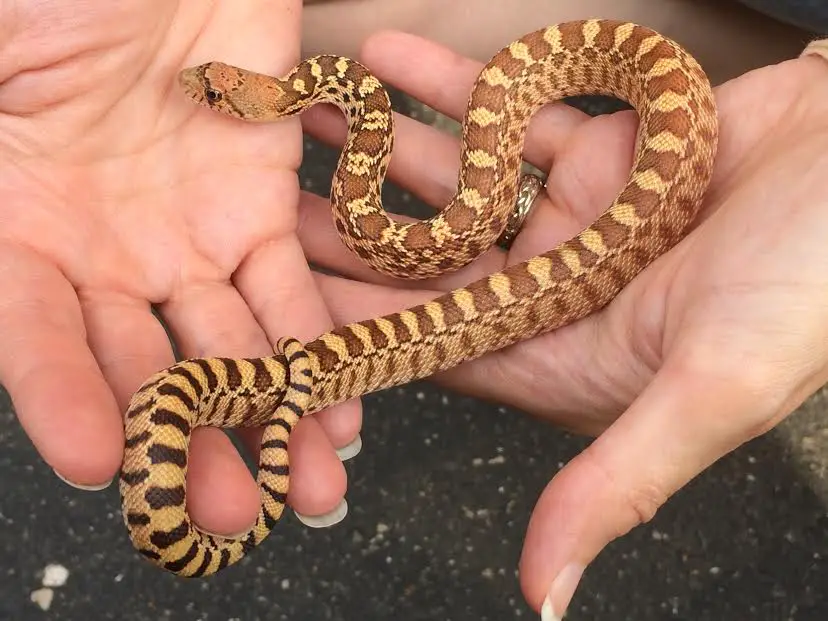
How to Care as a Pet
If taken in captivity, since they are not a high-maintaining reptile, your responsibility as a breeder is to ensure that their housing is in good order and that they are receiving a proper diet. They will thrive in captivity for many years if their basic needs are met.
1) Cage and Habitat
You can place these snakes in aquariums, glass terrariums or plastic cages designed for reptiles. It is advisable to make use of housing that is durable, easy to clean and plenty of floor space. Your Gopher snake grows long that is why it is important to invest in a big tank even though you are starting with hatchlings.
You need to make sure that their housing becomes a habitat where their natural environment is mimic. There should be a climbing tree or a log where it can climb and there should be a deep substrate for them to burrow. Your pet needs to move so that they could still have a way to exercise to avoid different health problems. Aside from providing them with the things that their natural environment has, as a breeder it is also your responsibility to make sure that their housing clean at all times because if they stay in unhygienic conditions, it may cause health problems that may lead to extreme illness or death.
2) Temperature
The ideal environmental temperature of the Gopher snake in captivity is between 70-85 degrees Fahrenheit. You may be needing to provide them with lighting equipment, make sure that it won’t add up too much on the temperature that may affect the humidity levels. The temperature would also influence the behavior and temperament of these snakes, if the temperature is at the optimum level then they are at their desirable attitude.
3) Moisture
In the wild, the Gopher Snake is usually found in semi-arid conditions that have very little moisture in the air, this means that you will not be having problems maintaining moisture in their housing. A bowl of water in their place is already sufficient to make sure that the moisture level is maintained. You can also spray in water inside their housing to keep the environment moist.
4) Heating and Lighting
The lighting equipment that you should use should have a closer to room temperature. Light and heat are important to snakes especially after every meal because they will generally remain under the light basking for two days straight as they need additional heat on their system to help them aid their digestion. UVB lighting is also advisable especially during the shedding period, an optimum usage would be at least 10 hours per day.
When taking care of corn snakes at home, prepare a temperature gradient with light, cable, or under tank heat pad. The ideal temperature for Gopher snakes is at least 70-85 degrees Fahrenheit. It is advisable to increase the housing’s humidity during the shedding period, you can do this by adding a damp paper towel or damp moss where the snake will shed.
5) Feeding
In the wild, your pet tends to eat a wide variety of animals and rodents but in captivity, rats or mice will do. You can also give them treats such as quail or frozen chick. If your pet vomits and swallows its food again, that is an indication to rest the feeding for two weeks before starting it again with small meals and gradually increasing it to the routine meal.
6) Water
Make sure to always place a bowl of fresh water to your snake’s tank for its hydration. Always clean this bowl of water regularly especially when it has been soiled.
7) Handling
Handling your pet once in a while will help you get along with them. This is also a way for you to check they’re well being where you can observe the parts of their body clearly. Tongue flickering and actively moving around are the signs that your pet is healthy. If you observe something unusual or if it shows dull behavior then don’t hesitate to visit a veterinarian.
Common Gopher Snake Health Problems
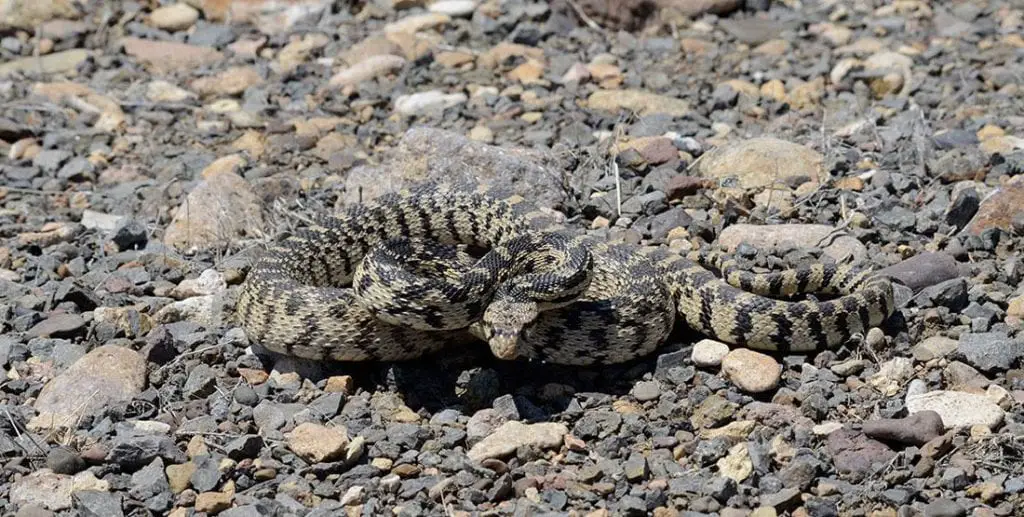
1) Anorexia
Anorexia or refusal to eat is one of the common health problems of gopher snakes. In the wild, usually during fall and winter season, it is their time to lower down their activity including eating until spring. This can be concerning for pet owner but this is just a normal thing they do to adjust. During this period, it is still a must to observe that they still look healthy because if not, their behavior of not eating means something else.
2) Blister Disease
Blister disease or vesicular dermatitis is an infection underneath the snake’s scales and is commonly due to unsanitary cage conditions especially if they are placed in a too damp or wet housing. If this disease is not cured, it may cause some lesions into your snake’s skin leading to septicemia which is fatal. Blisters along your snake’s body are the first sign so take it to a veterinarian so that they could give antibiotics to cure it and be sure to return it in a clean and sanitized environment.
3) Parasites Infestations
Like all reptiles, they can catch parasites. Seeing parasites in your pet’s habitat is just a normal thing but this is an indication that your pet is staying in a poor and unhygienic environment. Some of these parasites are tapeworms, mites, roundworms, ticks, and flukes. Just bathe your snake regularly and these parasites should go away.
Other Health Conditions
1) Pneumonia and respiratory issues
This health condition among snakes brings high mortality rates because it causes nasal discharge making it difficult for them to breathe.
2) Regurgitation
This is a health condition where your pet has the inability to digest certain kinds of food, especially those with hairs or feathers.
3) Egg binding
This usually occurs to female snakes where they have difficulty giving birth because the size of the egg is too big if this happens, the eggs stuck and may cause sepsis that may lead to death.
Preventing Illness
Just like any other reptiles, for you to be able to prevent different health conditions and illnesses, maintaining its health is necessary. Sickness is just normal, there is no assurance that your pet will not get sick but it is important to equip yourselves with proper knowledge on how to have first aid so that it won’t worsen its condition. If you observed that your pet is suffering from health conditions listed above, it is best to take it to a veterinarian for proper care.
How to Handle Properly?
A newly hatched Gopher snakes are naturally nervous and defensive. It is quite normal for these species to hide to feel secure but they do not have the ability to harm people. When taken in captivity, it is important to give your pet sometime before it can get accustomed to its environment. Feeding your Gopher snake is a good way for them to get comfortable at your presence, give it at least 3 feedings and for sure your pet will already be conditioned.
The proper way of holding your Gopher snake is through its side instead of holding it from the top. Every time you hold them, make sure that you are just relaxed because snakes can feel tension and fear and this might scare them too. Your Gopher snake has the ability to recognize you as its owner that is why in captivity, you can tame it quickly.
Availability – Where to Get One?
Gopher snakes are readily available at pet shops, online reptile stores, reptile exhibits, and expos, as well as direct breeders. It is important to adopt pets that are captive-bred snakes to ensure their health and so that it is a parasite-free snake. You will also get detailed information about the age, history, and genetics of the snake if acquired in a pet shop or online reptile store.
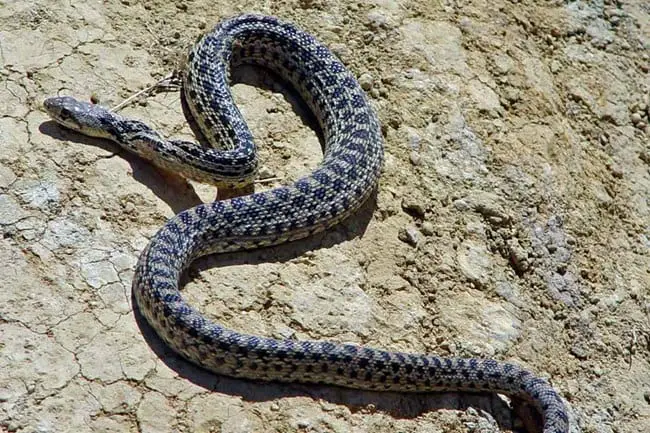
Fun Facts about Gopher Snake
1) They are all over the world
Nowadays, Gopher snakes are distributed around the world and they are not included in the list of the endangered species list. The only area where these species don’t thrive is in Alaska. If you see a Gopher snake in the urban territory, there is a high possibility that it has followed a prey.
2) Gopher Snakes are Great for the Environment
Like other snakes, they play an essential role in helping maintain the ecosystem by managing the rodent population. Some farmers see snakes useful as they eat small animals that destroy their crops.
3) They are Chameleonic
They are known to be chameleonic because, like chameleons, they have the ability to change their colors depending on their surroundings for camouflaging.
4) They are considered as gentle giants
If taken in captivity, you will not have a problem handling this large snake if you would provide it with a substantial terrarium where it could stretch out, burrow and climb.
5) They have a unique defense mechanism
They mimic the way how rattlesnakes warn away potential predators by curling into an “s” shape and hissing loudly but their unique way of fleeing predator is to hiss at their mouths that are firmly closed to relay an idea that they do not have fangs.
6) They are sun worshippers
Gopher snakes love to burrow and live underground but they cannot resist the sun. They make sure to bask so that they will keep warm at nighttime. However, absorbing the sun’s rays more often post safety issues such as skin cancer and basking makes them defenseless against swooping hawk, or a hunting coyote.
7) They are reclusive unless it’s mating season
Gopher snakes are solitary reptiles that prefer their own company, maybe because of their large size that lives in small surroundings. They only become sociable during the summer season or when the mating season is near.
FAQ Section
Are gopher snakes dangerous?
Despite their length (up to 9 feet) and large body size, they do not pose a danger to humans. They are sometimes killed by people because they are mistaken to be rattlesnake which is poisonous.
Why are gopher snakes called gopher snakes?
Their Latin name “catenifer” means “chain bearing” due to its splotched pattern on their body while their common name, gopher snake refers to the burrowing rodent because they inhabit abandoned gopher holes.
Do gopher snakes bite people?
They do not have poison that can severely hurt humans and they also attack with their mouths closed. They can bite but this would be their last resort.
Do gopher snakes eat other snakes?
Yes, they also eat other snakes that are smaller than them. In fact, they have a chance to eat a gopher snake-like them especially those hatchlings.
Can gopher snakes breed with rattlesnakes?
Rattlesnakes cannot be breed with other snake species. There is no such thing as a gopher snake and rattlesnake hybrid.
How often do gopher snakes eat?
An adult Gopher snake should be fed at least once every two weeks. You should closely monitor their diet so that they won’t become overweight and obese.
Can you buy gopher snakes?
Yes, you can buy gopher snakes at different pet stores or online shops. Snake collectors often have these species.
Are Gophers bad for your yard?
Gophers can cause extensive damage to your lawn because they love to dig on the ground weakening the foundations of the soil in your lawn.
How do you tell if a Gopher snake is a male or female?
The male Gopher snake has hemipenes that are located below the cloacal (vent)on the opening along with their tails. This sex organ is housed inside the scale of the snake making it not visible at a glance. Females do not have this organ.
Can they cry?
Snakes never cry. The way how they drain fluid is through the pair of nasolacrimal ducts through their mouth. Because these ducts are attached to the skin, their tears cannot flow from their eyelids.
What role do cage “hides” play in the care of my pet?
A hide is a type of accessories places inside the housing of your snake where they can hide. It allows them to instinctively feel safe from predation.
Is there a need to bathe my Gopher snake?
Bathing helps in relieving issues such as constipation and different skin problems in your snake. It also promotes shedding and kills pest infestations. When bathing your snake, make sure to use filtered water or warm spring.
Can multiple Gopher snakes be housed together with no problem?
It is not really recommended to house together multiple Gopher snakes. It is recommended to have one Gopher snake per cage. This is due to the possibility of feeding confusion by one or multiple snakes.
How often do Gopher snakes shed?
As your Gopher snake continues to grow, it will shed its skin. Typically, it occurs once every few weeks. As the snake grows older, the gap between sheds also increases. When they have reached adulthood, Gopher snakes shed once every few months.
Is it possible to handle a corn snake while shedding?
Yes, it is possible to handle it immediately after shedding but it is not best to hold it before it shed because, during this phase, they tend to become irritable.

